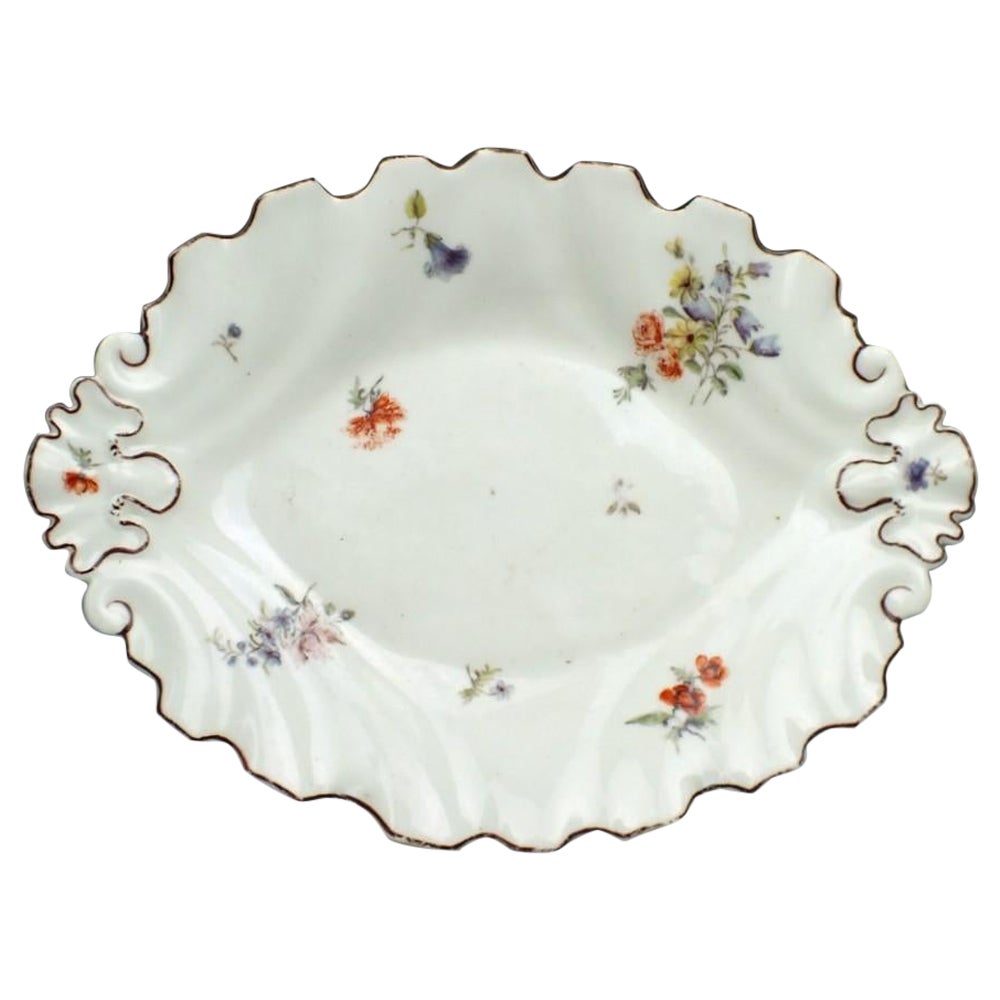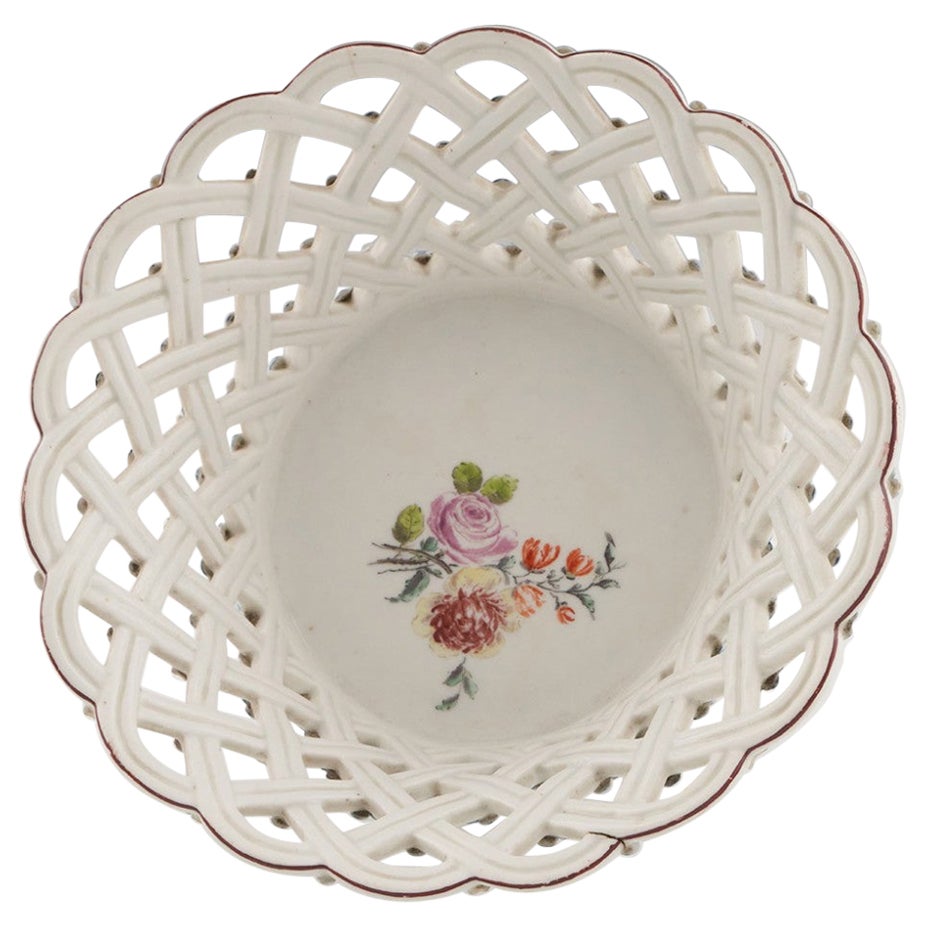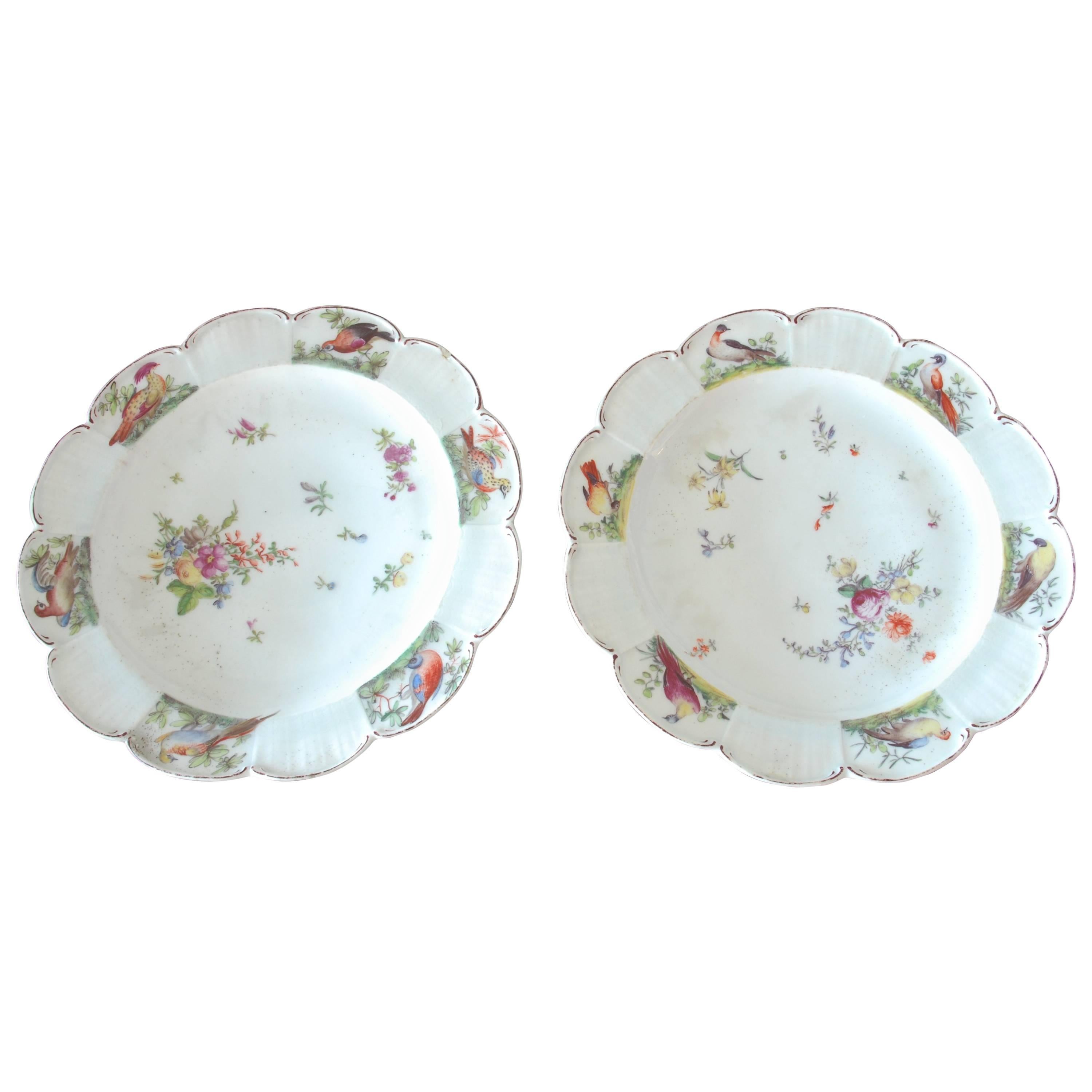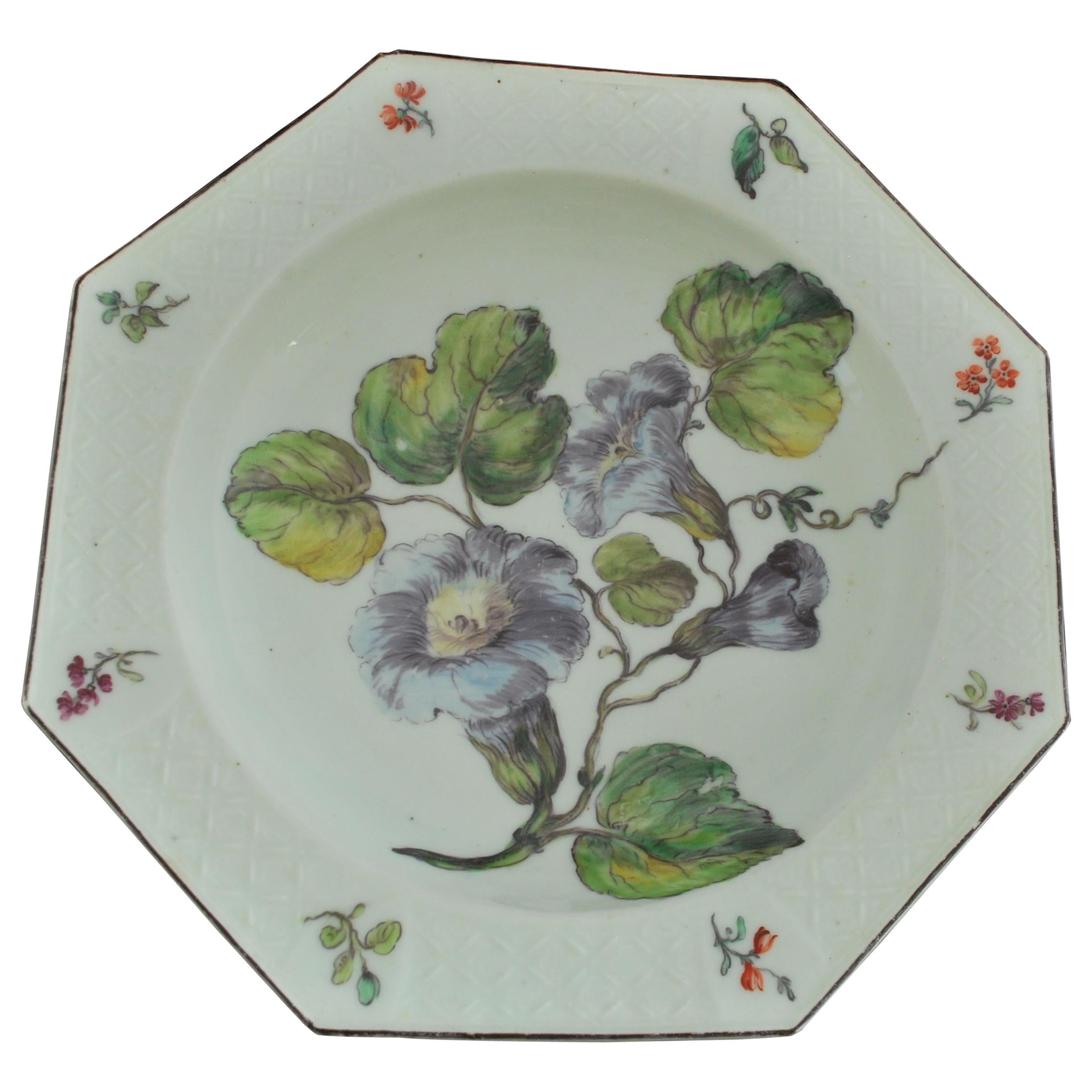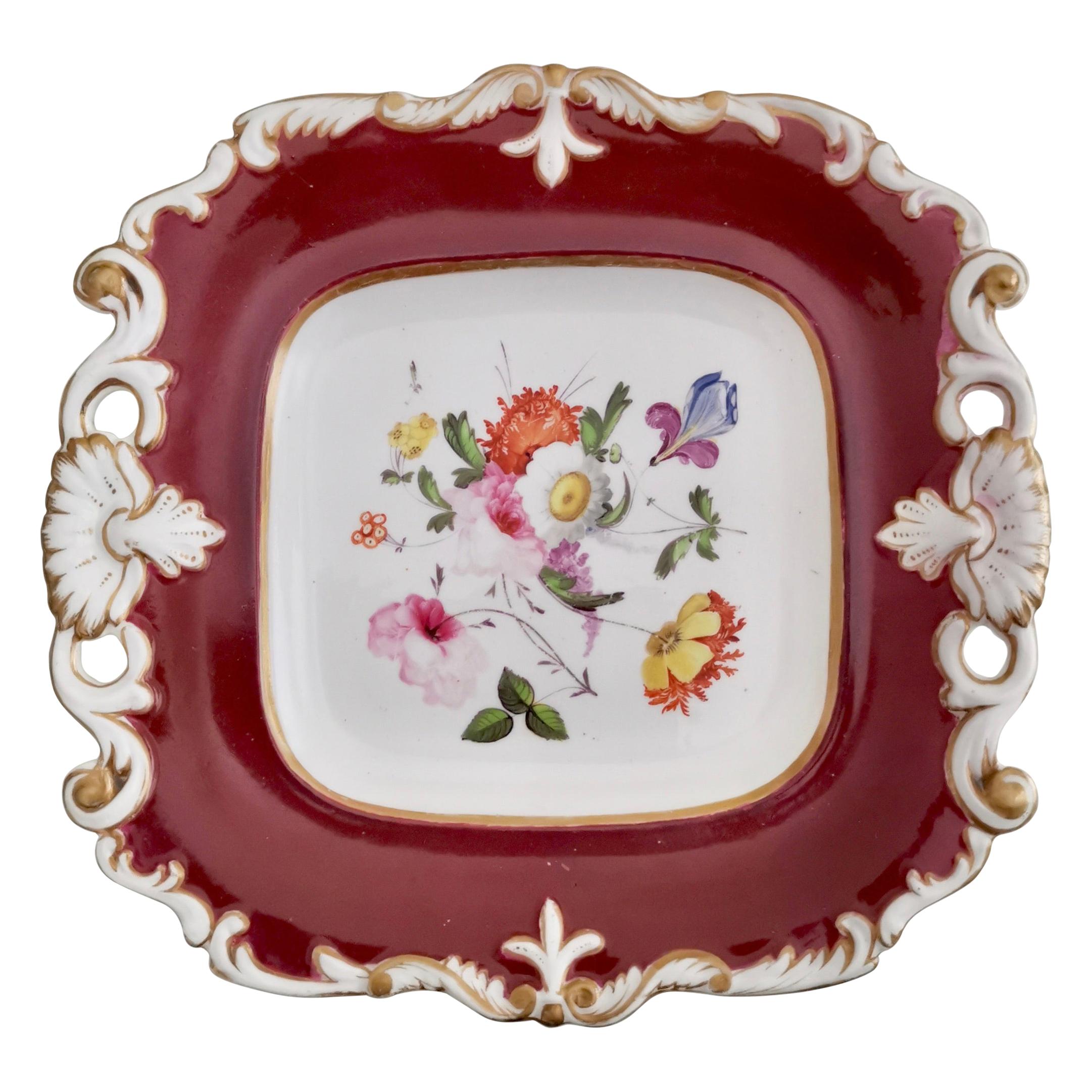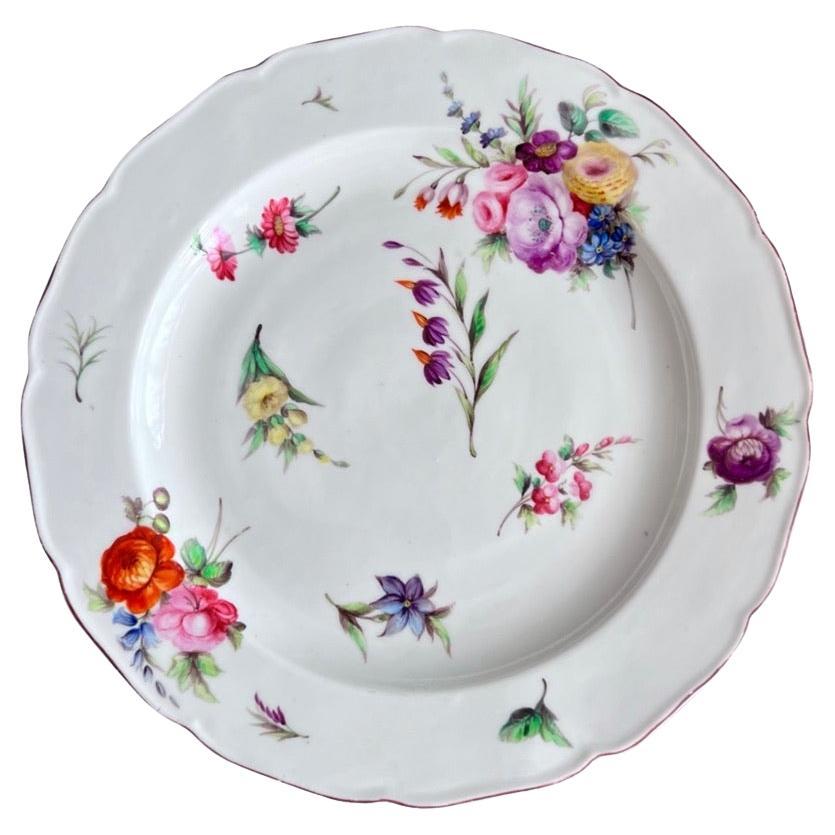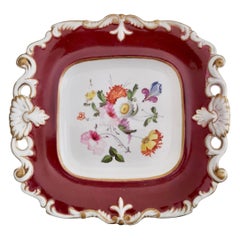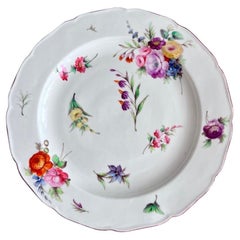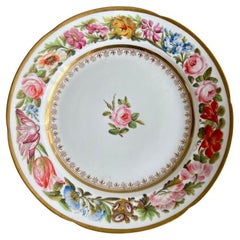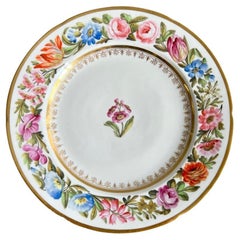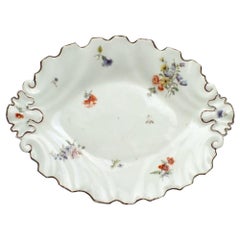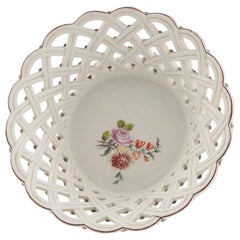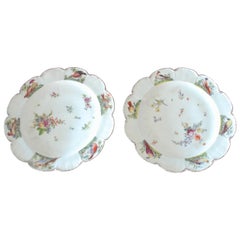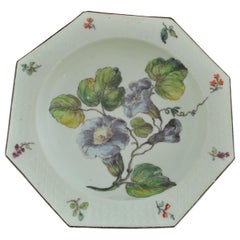Items Similar to Chelsea Plate, Feather Moulded with Flowers, Red Anchor Mark, ca 1755
Want more images or videos?
Request additional images or videos from the seller
1 of 11
Chelsea Plate, Feather Moulded with Flowers, Red Anchor Mark, ca 1755
About the Item
This is a beautiful plate made by Chelsea in circa 1755, which is known as the "Red Anchor" period of the factory.
Chelsea was one of the very early adopters of porcelain in the British china industry. Founded in 1744 the Chelsea pottery was for about 40 years the leading maker of fine chinaware, excelling in their sense of style, perfection and constant innovation and inspiring many following generations of china makers.
The company was started by French silversmith Nicholas Sprimont and you can see the influence of the French style of silverware in the shape of this feather-moulded plate, which was taken from an previous version in silver that Sprimont made early in his career.
Chelsea items are very rare as production levels were still low at the time and of course many items simply have not survived. The Chelsea pottery was only in production for about 30 years, which further adds to the scarceness of the items; it is rare to come across Chelsea items.
The plate is moulded in the "feathered" shape with fine feather-like shapes on the rim that have been picked out in puce and aquamarine green. This shape was inspired by the silver items that Nicholas Sprimont would have designed previously. There are very finely painted wild flowers dotted all over the plate; these are not placed in planned locations, but where ever there was a blemish to hide, as was usual at the time. This creates a very playful and spontaneous effect that would be impossible to design in a planned manner.
This plate is marked with a red anchor mark, which dates it between 1753 and 1758. It also has a "Falcon House Collection" label, presumably of the collection it previously belonged to.
Condition report: The plate is in perfect antique condition without any damage, repairs, crazing or significant wear. It has a little area of scraping under the glaze of the rim (see last picture), which happened during production.
Antique British porcelain is never perfect. Kilns were fired on coal in the 1800s, and this meant that china from that period can have some firing specks from flying particles. British makers were also known for their experimentation, and sometimes this resulted in technically imperfect results. Due to the shrinkage in the kiln, items can have small firing lines or develop crazing over time, which should not be seen as damage but as an imperfection of the maker's recipes, probably unknown at the time of making. Items have often been used for many years and can have normal signs of wear, and gilt can have signs of slight disintegration even if never handled. I will reflect any damage, repairs, obvious stress marks, crazing or heavy wear in the item description but some minor scratches, nicks, stains and gilt disintegration can be normal for vintage items and need to be taken into account.
There is widespread confusion on the internet about the difference between chips and nicks, or hairlines and cracks. I will reflect any damage as truthfully as I can, i.e. a nick is a tiny bit of damage smaller than 1mm and a chip is something you can easily see with the eye; a glazing line is a break in the glazing only; hairline is extremely tight and/or superficial and not picked up by the finger; and a crack is obvious both to the eye and the finger. Etcetera - I try to be as accurate as I can and please feel free to ask questions or request more detailed pictures!
Dimensions: 21.5cm (8.5").
- Creator:Chelsea Porcelain (Maker)
- Dimensions:Height: 0.5 in (1.27 cm)Diameter: 8.5 in (21.59 cm)
- Style:George II (Of the Period)
- Materials and Techniques:Porcelain,Molded
- Place of Origin:
- Period:1750-1759
- Date of Manufacture:1755
- Condition:In perfect antique condition without damage, repairs, crazing or significant wear.
- Seller Location:London, GB
- Reference Number:Seller: A-CHE061stDibs: LU4805119564272
About the Seller
5.0
Gold Seller
Premium sellers maintaining a 4.3+ rating and 24-hour response times
Established in 2016
1stDibs seller since 2019
225 sales on 1stDibs
Typical response time: 2 hours
- ShippingRetrieving quote...Shipping from: London, United Kingdom
- Return Policy
Authenticity Guarantee
In the unlikely event there’s an issue with an item’s authenticity, contact us within 1 year for a full refund. DetailsMoney-Back Guarantee
If your item is not as described, is damaged in transit, or does not arrive, contact us within 7 days for a full refund. Details24-Hour Cancellation
You have a 24-hour grace period in which to reconsider your purchase, with no questions asked.Vetted Professional Sellers
Our world-class sellers must adhere to strict standards for service and quality, maintaining the integrity of our listings.Price-Match Guarantee
If you find that a seller listed the same item for a lower price elsewhere, we’ll match it.Trusted Global Delivery
Our best-in-class carrier network provides specialized shipping options worldwide, including custom delivery.More From This Seller
View AllSamuel Alcock Porcelain Plate, Maroon with Flowers, Regency, ca 1825
By Samuel Alcock & Co.
Located in London, GB
This is a very striking and rare dessert plate made by Samuel Alcock around the year 1825. The plate is square and has the "inverted shell" moulding with pierced borders, a deep maro...
Category
Antique 1820s English Regency Dinner Plates
Materials
Porcelain
Worcester Porcelain Plate, Flower Sprays by James Giles, ca 1770
By James Giles, 1st Period Worcester Dr. Wall
Located in London, GB
This is a beautiful large plate made by Worcester in about 1770 in their First or the "Dr Wall" period. The plate has a pleasing slightly lobed rim, a white ground and beautifully pa...
Category
Antique 1770s English George III Porcelain
Materials
Porcelain
John Rose Coalport Plate, Abundant Flowers, T. Baxter Studio, ca 1805 (1)
By Thomas Baxter, Coalport Porcelain
Located in London, GB
This is a stunning and extremely rare plate made by Coalport around the year 1805, and decorated in the London studio of Thomas Baxter.
We have one more of these plates in stock, pl...
Category
Antique Early 1800s English George III Porcelain
Materials
Porcelain
Coalport John Rose Plate, Abundant Flowers, T. Baxter Studio, ca 1805 (2)
By Coalport Porcelain, Thomas Baxter
Located in London, GB
This is a stunning and extremely rare plate made by Coalport around the year 1805, and decorated in the London studio of Thomas Baxter.
We have one more of these plates in stock, pl...
Category
Antique Early 1800s English George III Porcelain
Materials
Porcelain
Machin Set of 6 Plates, Moustache Shape, White with Flowers, ca 1825
By Machin
Located in London, GB
This is a beautiful set of 6 dessert plates made by Machin around 1825, which is known as the Regency period. The items have the famous "moustache" moulding picked out in gilt, a sim...
Category
Antique 1820s English Regency Dinner Plates
Materials
Porcelain
Barr Flight & Barr Plate, Gilt Vermiculé, Flowers by W. Billingsley, ca 1809 (2)
By William Billingsly, Barr, Flight & Barr Worcester
Located in London, GB
This is a beautiful plate made by Barr Flight & Barr between between 1808 and 1810. The plate was decorated by the famous painter William Billingsley with a gilt vermiculé (or vermic...
Category
Antique Early 1800s English Regency Porcelain
Materials
Porcelain
You May Also Like
Chelsea Porcelain Oval Moulded Silver Shape Dish, c1755
By Chelsea Porcelain
Located in Tunbridge Wells, GB
Chelsea Porcelain Oval Moulded Silver Shape Dish, c1755
Additional information:
Date : c1752-56
Period : George II
Marks : Red anchor
Origin : Chelsea, London, England
Colour : Poly...
Category
Antique 18th Century English George II Porcelain
Materials
Porcelain
Chelsea Porcelain Reticulated Basket c1755
By Chelsea Porcelain
Located in Tunbridge Wells, GB
Heading : Chelsea porcelain reticulated basket
Date : c1755
Period : George II
Origin : Chelsea
Pattern : Pale blue and yellow applied forget-me-nots. Painted central floral bouquet
...
Category
Antique 1750s British George II Porcelain
Materials
Porcelain
Pair of Bird Plates, Chelsea, circa 1755
By Chelsea Porcelain
Located in Melbourne, Victoria
A pair of scalloped dessert plates, painted with bunches and sprays of flowers, with attractive naturalistic birds arranged around the outside.
Red anchor mark.
Category
Antique Mid-18th Century English Neoclassical Porcelain
Materials
Porcelain
Soup Plate with Hans Sloane Type Painting, Chelsea, circa 1755
By Chelsea Porcelain
Located in Melbourne, Victoria
An octagonal soup-plate, decorated in the Hans Sloane style with morning glory, or convolvulus, to give its proper name.
Category
Antique Mid-18th Century English Rococo Porcelain
Materials
Porcelain
$5,360 Sale Price
20% Off
Dessert Plate with Fancy Bird, Chelsea Gold Anchor, circa 1765
By Chelsea Porcelain
Located in Melbourne, Victoria
A fabulous dessert plate, molded with swirling leaves highlighted with blue and gilt; the centre with a fabulous bird and insects.
Category
Antique Mid-18th Century English Rococo Porcelain
Materials
Porcelain
Large Dish, Chelsea, circa 1755
By Chelsea Porcelain
Located in Melbourne, Victoria
A large platter, probably once associated with tureen. Beautiful flower painting, possible done outside the factory at the Giles studio in London, or perhaps at the Chelsea studio by a painter who had previously worked there. The tulip, heartease, and others look very Giles.
One of the most distinctive features of Chelsea porcelain is its intricate floral painting, which often featured detailed, lifelike renditions of flowers and other botanical subjects. The factory employed skilled artists who were trained in the art of flower...
Category
Antique Mid-18th Century English Neoclassical Porcelain
Materials
Porcelain
Recently Viewed
View AllMore Ways To Browse
White Small Plates
White Porcelain Plates
Vintage Painted Plates
Antique Finger Plate
Antique Finger Plates
Antique Chelsea Porcelain
Wedgwood Patrician
Wedgwood Runnymede
Wedgwood Water Nymph
Winfield Pottery
Zebra Transferware
Alfred Meakin Audubon Bird Plates
Alfred Meakin
Andy Warhol Dinnerware
Aqua Blue Hobnail Dinner Plates
Arabia Dinnerware
Bernardaud Artois Bleu
Copeland Spode Patricia
